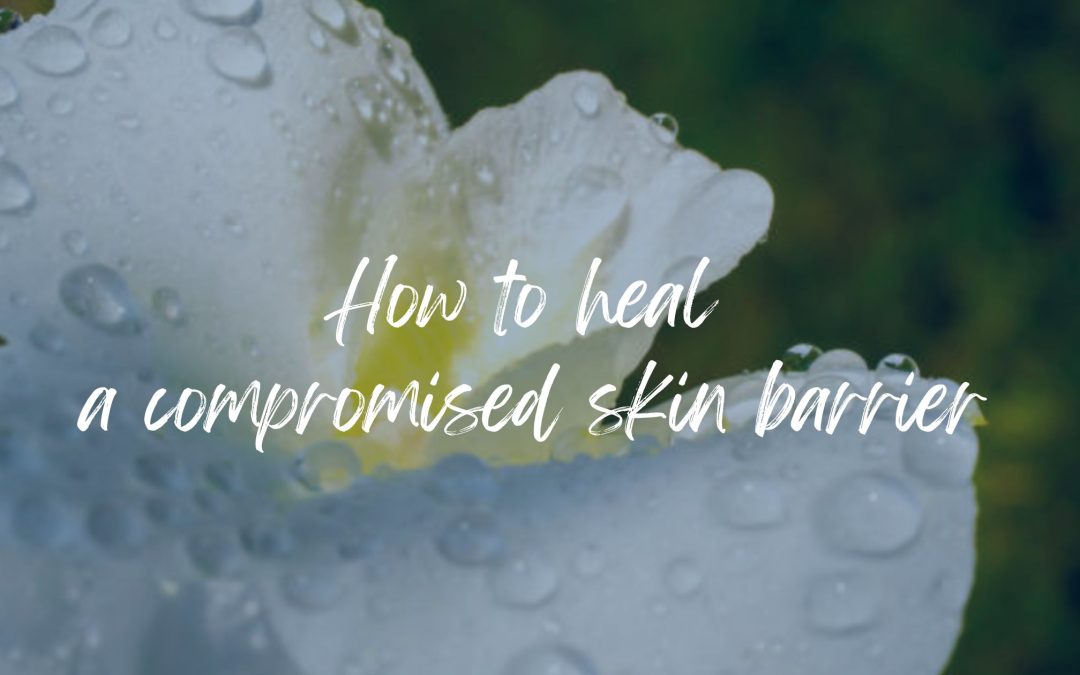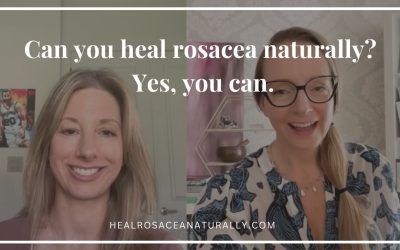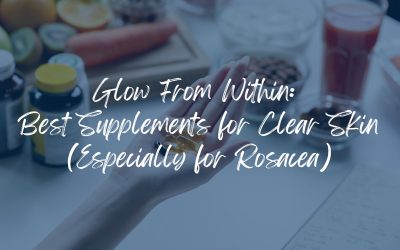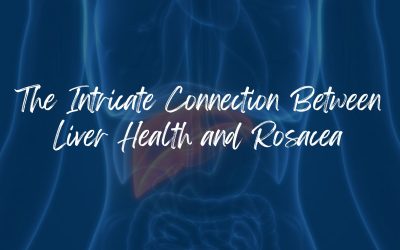A major symptom of rosacea is a compromised skin barrier which results in redness, enlarged pores, dryness and peeling.
In one article, rosacea was classified as a disease of “cathelicidins compromising the skin’s innate immunity”. Cathelicidin peptides have a unique capacity to be both vasoactive and proinflammatory.
The article also points to the increased density of Demodex mites in rosacea patients compared to the control group. While everyone has mites on their skin, because rosacea skin is already sensitized (or compromised), the mites do more damage. The Demodex (effectively parasites) create inflammation which is seen in the papules and pustules as well as granulomas.
I have previously written about natural solutions to treat Demodex folliculorum.
Beyond the surface of the skin, the pathophysiology of rosacea involves a number of factors that must be explored in order to regain clear skin:
- Gut dysbiosis
- An overactive immune response
- The possible presence of pathogens / parasites / viruses / H pylori
- Liver toxicity
- Emotional or traumatic stress
Based on all these factors, it makes sense to adopt a holistic approach that addresses both outer AND inner inflammation.
In this article, we’re going to focus on ways we can support the skin barrier with the help of botanicals. I’ll specifically share tips that will help rehydrate rosacea skin, as well as lower inflammation and make the skin’s microbiome less favorable to Demodex mites. We’ll also touch on nutrition and its crucial role in healthy skin.
Rosacea skincare: the importance of using the right face oils
There are lots of lovely face oils on the market, but very few were formulated FOR rosacea: to tackle Demodex, redness, inflammation, granulomas, acne, and dehydration.
Look for oils that support the skin barrier via potent, organic oils packed with active phytochemicals. For rosacea, you’ll want to favor face oils that are antibacterial, anti-inflammatory, antifungal, slightly astringent (to tighten pores) but not drying.
Black cumin seed and Neem oil infused with flowers or plants that bring extra support to the skin’s barrier such as Calendula (wound healing), Rosa damascena (slightly astringent) or Chamomile (soothing and balancing).
Essential oils for rosacea
Essential oils such as Melaleuca, Frankincense and Helichrysum italicum have been shown to be effective in reducing mites and diminishing granulomas. The Radiantly Clear EOS Roll-On was formulated with the above-mentioned essential oils.
The active compounds found in blue tansy — chamazulene, a mighty anti-oxidant — and a-bisabolol are powerhouses known for their anti-histaminic, anti-inflammatory, anti-viral, and anti-microbial properties. These active compounds have been researched and proven effective for helping to relieve inflammation as well as redness. You’ll find Blue Tansy in the Blue Goddess Anti-Redness Face Oil.
When using essential oils, a balanced formula is key, otherwise, they will aggravate the skin barrier. Always patch test before using essential oils. Never put undiluted essential oils on inflamed, rosacea skin.
The water component
Oils alone won’t be enough to bring moisture back to dehydrated skin. You’ll want to make sure you add a water component to your routine such as a pure hydrosol (flower water), aloe, or water-based serum.
Hydrosols, produced by the steam distillation of aromatic plants, are safe to use on sensitive, rosacea skin. Depending on which flower or plants are used, they can soothe the skin, tighten pores and promote wound healing. They’re wonderful to hydrate and balance the PH of the skin.
Other ingredients known to add hydration are hyaluronic acid, niacinamide and squalane.
Lock-in moisture
One of the reasons I love balms so much for dry, rosacea skin is that they lock in moisture.
Balms are ideal to protect the epidermis from harsh winter winds, air conditioning and dry (indoor or outdoor) climates.
Balms are also a great way to even out the skin before applying makeup, although I don’t recommend using powder over a balm (it will cake). Plus, typically powders are drying. Instead, opt for a hydrating foundation such as Un-Cover from RMS.
One of my all-time favorite balms is the Blue Goddess Anti-Redness Extreme Hydration Balm.
Hydrating skincare routine
STEP 1: Once or twice a week, use a gentle exfoliant to get rid of dead skin cells. The gentle exfoliation will prep the skin to receive the serum and face oil. *If your skin barrier is already extremely compromised, skip this step, give your skin time to heal. When your skin can tolerate, gently pat the exfoliant powder into the skin, DO NOT SCRUB. Remove by splashing lukewarm water.
STEP 2: Spritz pure soothing flower water. Look for hydrosols made with Rosa damascena, Carrot or Chamomile. Ideally, the hydrosol would be pure and not contain alcohol such as this one.
STEP 3: Apply water or aloe based-serum
STEP 4: Layer favorite face oil formulated with hydrating & soothing plants such as Calendula officionalis
STEP 5: Spritz hydrosol again, pressing the flower water into your skin
STEP 6: Layer in moisture-locking balm to targeted, dry areas
You might need to repeat these steps midafternoon if your skin gets overly dry from indoor heat, sun exposure or cold weather.
Feel free to also repeat in the evening and don’t forget that balms are amazing to use with a gua sha tool. I wrote about gua sha and rosacea here.
Click here for more rosacea skincare tips.
When switching to natural skincare
It’s important to give your skin time to adjust when changing skincare products, especially when moving off toxic skincare (I’m looking at you, Cerave!). In fact, your skin might go through a detox period where it gets worse before it gets better. If that happens, don’t panic. Be patient and give your skin time to adjust.
Hydrating with food
Ultimately, the best way to hydrate (and heal) skin is from within. The first step to regain a hydrated and string skin barrier is to eliminate foods that are “drying” or inflammatory and eat a plant-focused, anti-inflammatory diet.
Examples of drying or inflammatory foods and drinks:
- Coffee
- Alcohol
- Sugary drinks
- Processed foods
- Sugar (creates metabolic imbalance and inflammation at the cell level)
- Eating too much meat (meat is acidic)
Drying spices
Don’t forget that spices and herbs can be drying (or astringent) such as nutmeg and cardamom for example. On the other hand, you have “hot” spices (cinnamon, clove…) that build heat in the body and may, as a result, create too much heat in pitta (fire) constitutions.
Skin-loving, hydrating foods & supplements
One of the fastest ways to bring hydration back to your skin (and lower inflammation) is to eat a plant-based diet that is alkalizing to the body. (Veggies are alkalizing, meat is acidic.)
Incorporate healthy fats in your diet such as avocados, wild-caught fish, olive oil, coconut oil, olives, coconut yogurt, MCT oil, nuts and seeds…
Include a variety of anti-inflammatory superfoods like turmeric and antioxidant-rich berries.
*Please note that these are general recommendations and that you’ll have to adjust if you’re on a low FODMAP or low histamine diet. More on the rosacea diet here.
Skin-loving supplements
I don’t typically make “general” supplement recommendations as I prefer designing a specific protocol based on bio-individuality, but here are a few I fell are essential to most people healing rosacea…
Omega-3 supplements and Borage seed oil are essential to healthy skin.
Vitamin C is also a building block of beautiful skin. (Liposomal vitamin C is more absorbable and better used by cells.)
Herbal teas & decoctions
Herbal tea infusions and decoctions are a great way to add of the benefits of plant medicine to your everyday life. (Decoctions are made with more plant matter and steeped for hours or longer when using roots. Flowers and leaves are steeped, not boiled. Roots are boiled.)
My favorite plant medicine for skin health are Calendula (gut soothing), Nettle (mineralizing), Lemonbalm (soothes anxious tummy), Liquorice and Peppermint (great in optimizing digestion).
Emollients herbs
Emollient herbs are mucilaginous and they’re used topically to help soothe and protect the skin. When taken internally, they will also have a soothing, emollient effect. Example marshmallow and Slippery elm are very soothing to the intestinal tract, you’ll often find them in gut repair formulas.
Examples of emollient herbs:
- Aloe vera
- Chickweed
- Marshmallow
- Plantain (found in the Appease Face Oil & Balm)
- Violet
Staying hydrated
Drinking the right amount of pure or filtered water is crucial for healthy, hydrated skin. But you’ll want to make sure the water molecules actually GET to your cells. A lot of people are dehydrated because they don’t drink enough water AND because the water molecule doesn’t get to the cells. If that’s the case, you may want to add a pinch of Pink Himalayan salt to your water or trace minerals.
Another way to optimize the quality of your water is to restructure it after it’s been filtered (I use a Berkey filter). I use the Analemma Wand to restructure my water and I love it. Restructuring water enhances the properties, quality and effects of drinking water by transforming it back into a coherent, liquid crystalline state. The effects of drinking structured water are health-enhancing because of its coherent, high-energy state.
Need guidance on your skin healing journey?
Rosacea Articles
Can you heal rosacea? Client success!
Can you heal rosacea? Client success! If you’ve ever felt frustrated or stuck in your journey to heal rosacea, I have something special for you. I recently sat down with Jessica, a client who’s completed my Vibrant & Radiant program. Her transformation is nothing...
Glow From Within: Best Supplements For Clear Skin (Especially Rosacea)
Glow From Within: Best Supplements for Clear Skin (Especially for Rosacea) When it comes to healing rosacea, what we put into our bodies is just as important as what we apply to our skin. If you’re dealing with rosacea, you know that redness, irritation, and flare-ups...
Rosacea skincare Demodex mites {Journey To Glow}
Rosacea Demodex Skincare Tips Live Zoom Community Call with Q&A Topics discussed in this video: Why I studied Functional Nutrition & Herbal Medicine for rosacea Why I created these products for Demodex mites (my personal journey) Brief overview of steps to...
{Video} Skincare Tips For A Rosacea Skin Crisis
Rosacea Skin Crisis Skincare Tips Live Zoom Community Call with Q&A I want to answer questions about the Radiantly Clear Rosacea / Demodex Skincare System and how to best use the products when your skin is in crisis. Please keep your questions coming, I will...
Exploring the Underlying Root Causes of Rosacea
Exploring the Underlying Root Causes of Rosacea In this blog post, we'll explore the underlying root causes of rosacea and the contributing factors that may lead to its development. Let's start with a better understanding of what is rosacea... Rosacea is characterized...
The Intricate Connection Between Liver Health and Rosacea
The Intricate Connection Between Liver Health and Rosacea Before we dive into the intricate connection between liver health and rosacea, let's take a look at how rosacea is defined by allopathic medicine. What is rosacea Rosacea, a chronic (but not incurable) skin...






